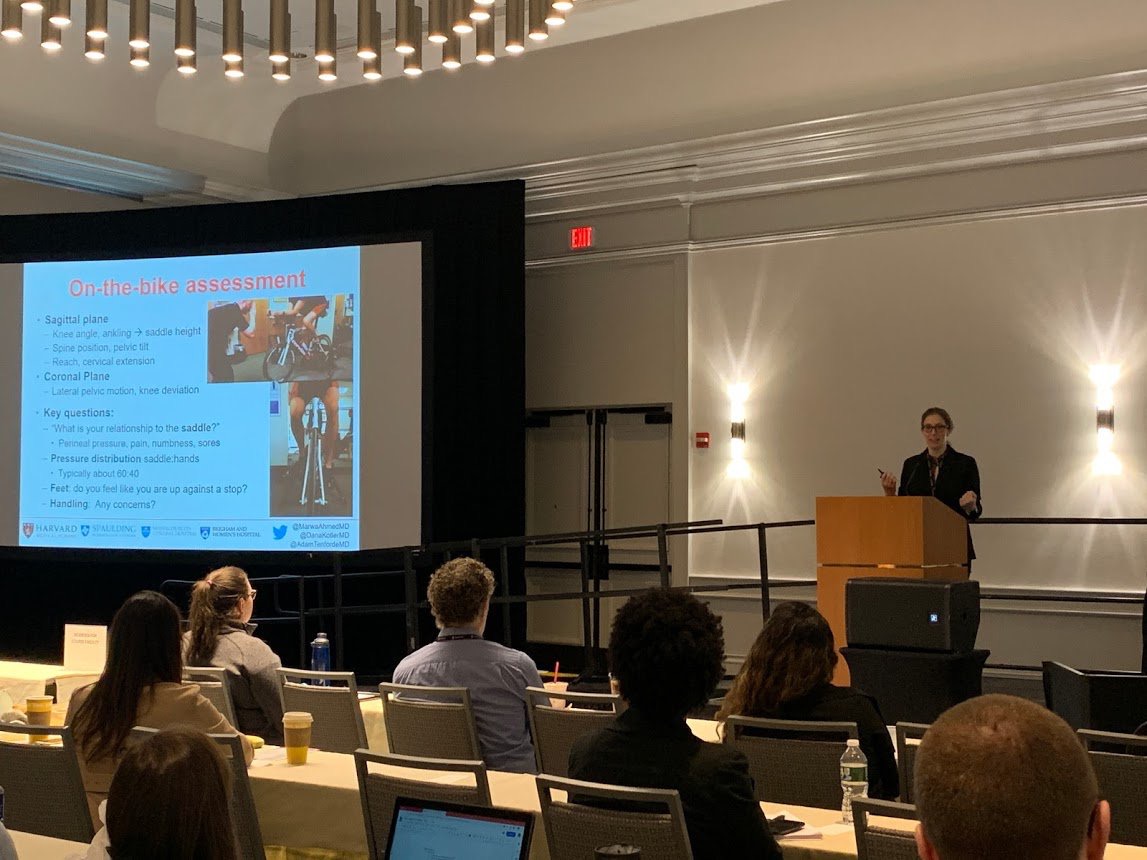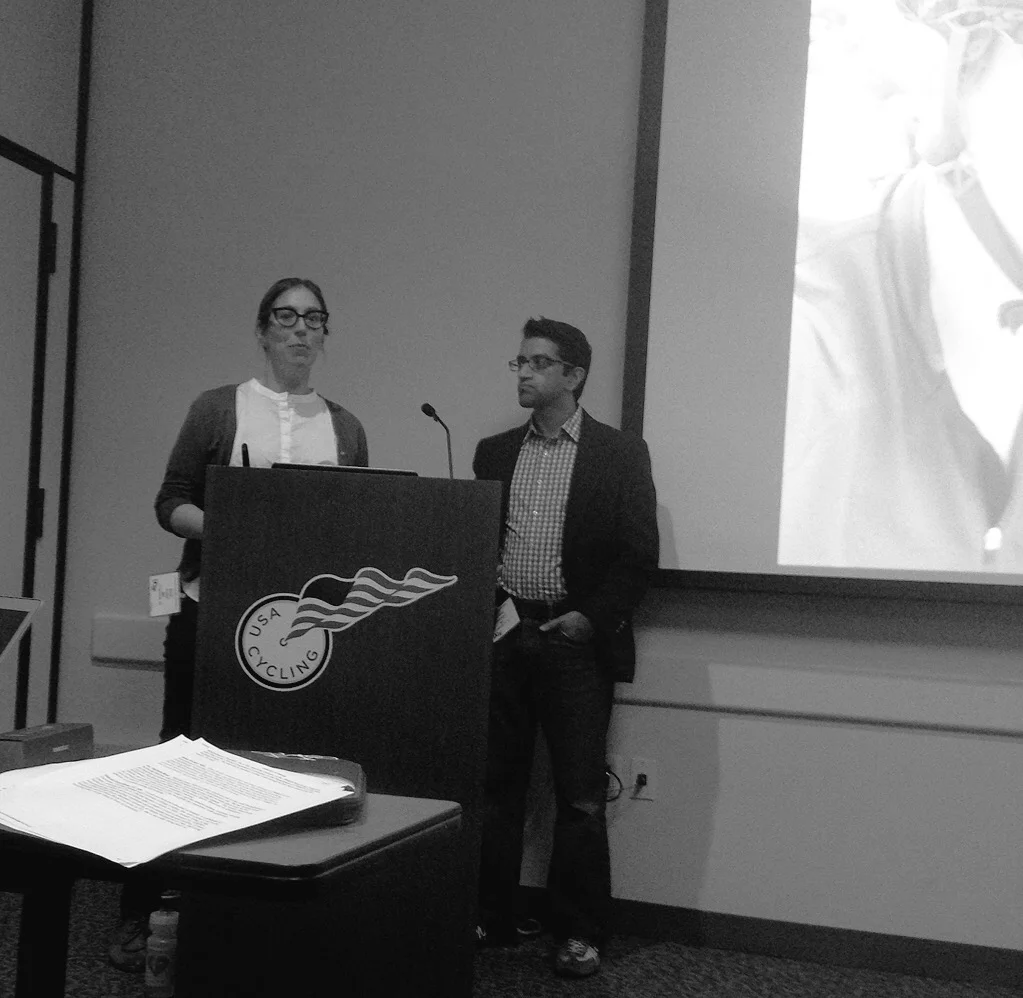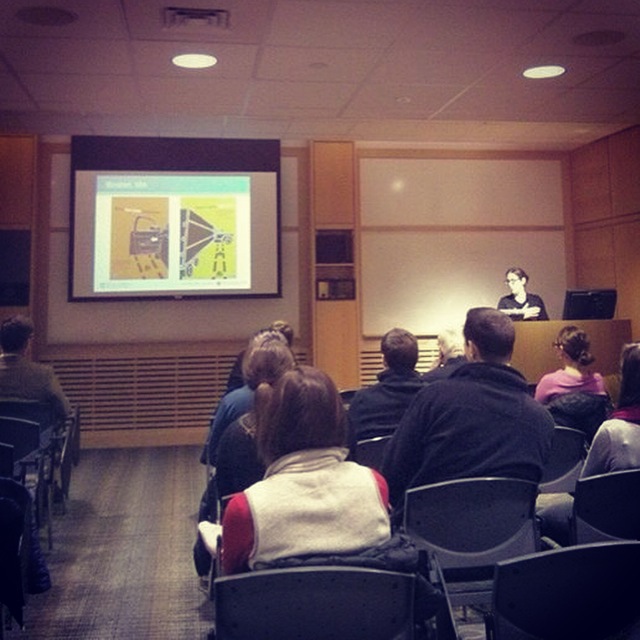Recent Publications
Kotler D, Rice S, Katz N, Gomes N, Holliday W, Zunti K, Moore J. Training and Injury Considerations in Female-Identifying Cyclists. Journal of Women's Sports Medicine. 2023 Jul 26;3(2):11-24.
Kotler DH, Cushman DM, Rice S, Gilbert C, Bhatnagar S, Robidoux CG, Iaccarino MA. Fear, anxiety, and return to sport after cycling crashes: a survey of cyclists. Physical Medicine and Rehabilitation Clinics. 2022 Feb 1;33(1):107-22.
Kotler DH, Iaccarino MA, Rice S, Herman S. Return to Cycling Following Brain Injury: A Proposed Multidisciplinary Approach. Physical Medicine and Rehabilitation Clinics. 2022 Feb 1;33(1):91-105.
Puleo RM, Barreveld A, Rice S, Plante AM, Kotler DH. Unique Concerns of the Woman Cyclist. Physical Medicine and Rehabilitation Clinics. 2022 Feb 1;33(1):61-79.
Cushman DM, Dowling N, Ehn M, Kotler DH. Triathlon Considerations. Physical Medicine and Rehabilitation Clinics. 2022 Feb 1;33(1):81-90.
Tenforde AS, Iaccarino MA, Borgstrom H, Hefner JE, Silver J, Ahmed M, Babu AN, Blauwet CA, Elson L, Eng C, Kotler D et al. Telemedicine during COVID‐19 for outpatient sports and musculoskeletal medicine physicians. PM&R. 2020 Sep;12(9):926-32.
Tenforde AS, Iaccarino MA, Borgstrom H, Hefner JE, Silver J, Ahmed M, Babu AN, Blauwet CA, Elson L, Eng C, Kotler D. Feasibility and High Quality Measured in the Rapid Expansion of Telemedicine During COVID‐19 for Sports and Musculoskeletal Medicine Practice. PM&R. 2020 May 18.
Tenforde AS, Beauchesne AR, Borg-Stein J, Hollander K, McInnis K, Kotler D, Ackerman KE. Awareness and comfort treating the female athlete triad and relative energy deficency in sport among healthcare providers. Nurse practitioner. 2020 Mar;3(2).
Rice S, Iaccarino MA, Bhatnagar S, Robidoux G, Zafonte R, Kotler DH. Reporting of Concussion-Like Symptoms After Cycling Crashes: A Survey of Competitive and Recreational Cyclists. Journal of Athletic Training. 2020 Jan;55(1):11-6.
Frontera WR, Silver JK, Rizzo TD. Essentials of Physical Medicine and Rehabilitation, Chapter 21: Elbow Arthritis. Elsevier Health Sciences; 2018 Dec 4.
Meyers AC, Bhatnagar S, Robidoux G, Kotler D. Results of an online community survey on cyclist's riding and racing habits, crash history, traumatic and chronic injury, and medical treatment. Journal of Science And Cycling, 6(2), 27-34. doi:10.28985/jsc.v6i2.324.
Joyce AA, Kotler DH. Core Training in Low Back Disorders: Role of the Pilates Method. Curr Sports Med Rep. 2017 May/Jun;16(3):156-161.
Kotler DH, Lynch M, Cushman D, Hu J, Garner J. Dancers' Perceived and Actual Knowledge of Anatomy. J Dance Med Sci. 2017 Jun 15;21(2):76-81
Kotler DH, Babu AN, Robidoux G. Prevention, Evaluation, and Rehabilitation of Cycling-Related Injury. Curr Sports Med Rep. 2016 May-Jun;15(3):199-206.
Upcoming Presentations
Primary Care Internal Medicine, Harvard CME course
Updates in General Internal Medicine for Specialists, Harvard CME course
Office Practice of Primary Care Medicine, Harvard CME course
Sports Medicine, Harvard CME course
Recent Presentations
*Apologies that these are out of date! To be updated shortly.
Harvard Sports Medicine Course 2021
May 4-7, 2021 - Cambridge MA
Lecture topic: Cycling Medicine
Updates in General Internal Medicine for Specialists 2021, Harvard CME course
February 2021, Virtual
Topic: Lower Back Pain
Primary Care Internal Medicine 2020, Harvard CME course
October 2020, Virtual
Workshop topic: Lower Back Pain
Updates in General Internal Medicine for Specialists 2019, Harvard CME course
January 27 – January 31, 2020, Fairmont Copley Plaza Hotel, Boston.
This course, with a combined faculty from the MGH and the Brigham, is designed to provide an deep dive into a whole range of general medical topics for specialists. We have participants from all the various disciplines of medical practice, from psychiatry, to surgery, to pathology, to anesthesiology, and more. We provide a week of quick, pithy, practical summaries. We get about 350 MDs from around the US, Canada. There are a number of international physicians who come to Boston for this Harvard course.
Topic: Lower Back Pain
Primary Care Internal Medicine 2019, Harvard CME course
October 21-25, 2019, Cambridge Marriott Hotel, Kendall Square, Cambridge, MA Workshop: Lower Back PainDay/Date: Thursday, October 24, 2019Time: 4:00 – 5:10 pm
Harvard Sports Medicine Course, 2019
June 2019
Unique Concerns of Female Cyclists, With Rozanne Puleo
Boston Children’s Hospital, Babson College, Wellesley MA
Harvard Sports Medicine Course 2019
May 15-17, 2019 - Cambridge MA
Lecture topics:
Leg Injuries, Neurovascular Etiologies
Hot Topics: Triathlon Medicine
Movement Dysfunction and Failed Rehab Syndrome–A New Paradigm in Treating Low Back Pain
Association of Academic Physiatrists (AAP) Annual Conference
February 22 2019, San Juan, Puerto Rico, with Amy West, David Johnson
Back pain is the world’s leading cause of disability and costs the US healthcare system $90 billion per year. Physiatrists are often the first-line providers for patients with back pain and yet we are not able to cure many of the patients we see. Often these patients suffer from what has been coined “Failed Rehab Syndrome” and have spent a great deal of time and money on treatments that have not worked. This is because traditional treatments such as physical therapy, core strengthening, and injections, treat symptoms of low back pain rather than actual cause. In this session, we will show how Movement Dysfunction is the root cause of back pain and discuss importance of treating back pain as a central nervous system disorder rather than a musculoskeletal problem. We will discuss what Movement Therapy is and how it differs from physical therapy. Also, we will show how treating faulty movement patterns can improve quality of life, prevent disability, and reduce pain. We will be joined by Dr. David Johnson, neurosurgeon from Australia, and founder of the first clinical practice to integrate this philosophy at a major tertiary hospital. We will examine the data collected from >500 patients and discuss patient cases.
Harvard Dance Medicine Course, 2018
Dance Medicine 2018 and Harvard Sports Medicine Course
9-12 May, 2018 - Cambridge, MA
Dancers are equal parts artist and athlete. Most dancers sustain one or more injuries during a career in part due to unique demands of strength and flexibility. This innovative one-day course addresses evaluation, treatment and rehabilitation of medical problems specific to dancers.Participants will have the opportunity to:
Learn the biomechanical factors that contribute to dance injuries, including strength and flexibility imbalances, motor control deficits, and technique errors
Develop a comprehensive approach to evaluation and management of dancers
Participate in hands-on workshops to hone clinical skills and learn innovative treatments for this population
“You are not your MRI” - A return to the basics - Back Pain as a Paradigm
The Body Across Medicine, Media, and Politics
Invited Lecture, November 2018, Wellesley College, Wellesley MA
MACC 2017, Capetown, South Africa
Collaborative Evaluation of the Cyclist - Role of Bike Fit
Implementation of a Cycling Medicine Program for Management of the Injured Cyclist
Medicine Africa Cycling Congress 2017
24 November 2017 - Capetown and Coetzenburg, Stellenbosch, South Africa
Inaugural conference in South Africa coinciding with the Origin of Trails mountain bike race. The first day consisted of lectures and interactive workshops by myself, Jeroen Swart, Wendy Holliday, and Borut Fonda, regarding skills, techniques, and technology for assessment of the cyclist with respect to performance as well as injury. The second day took place at the University of Stellenbosch and featured multiple speakers on all aspects of cycling medicine, including acute cycling injury, cardiovascular considerations, radiologic findings of cycling injury. Great content and beautiful venue, I look forward to this conference coming back next year!
AAPM&R 2017, Denver CO
Triathletes Have a Trilogy of Troubles - Evaluation and Treatment of Triathletes
American Academy of Physical Medicine and Rehabilitation Annual Assembly, Denver CO
Thursday, October 12, 2017
Participation in triathlons in the United States is at an all-time high, according to USA Triathlon, the sport's governing body in the United States. The group's membership has swelled from around 100,000 in 1998 to 550,446 last year. The Sports & Fitness Industry Association, a trade organization, estimates the total number of triathlon participants rose 59 percent from 2008 (1,251,000) to 2011 (1,992,000), according to the SFIA. This growth in participation has been accompanied by a growth in the support industry including personal trainers, performance optimization products and equipment specific for triathletes. The growth in triathlons as also caused an increase in triathlon-related injuries. Medical issues related to triathlons can be divided into three categories: pre-race training (performance optimization); race-day injuries; and post-race recovery (including acute injuries and chronic overuse injuries). Training for triathlons is unique and demanding as it requires proficiency in three sports: swimming, biking and running. Knowledge of training and equipment issues specific to triathletes is important to physicians working with these athletes.
Race-day medical issues and injuries include those common to endurance running events, but also encompass many other issues such as biking safety and bike-related injuries, swimming safety, weather and exposure changes, transition zone safety, etc. Race directors and physicians covering triathlons need to be keenly aware of the multitude of potential medical problems that can occur during the race.
Many fitness experts tout the benefits of cross-training for triathlons, citing improved overall fitness and the potential for reduced chronic overuse injuries. However, triathletes do experience both acute and chronic overuse injuries similar to marathon runners, cyclists and other endurance athletes.
Ultrasound Evaluation of Upper and Lower Extremity Nerves
American Academy of Physical Medicine and Rehabilitation Annual Assembly, Denver CO
Friday, October 13, 2017 (Lower Extremity)
Saturday, October 14, 2017 (Upper Extremity)
Interview, Doctor Radio, Sports Medicine Program
Sirius XM 110, June 29, 2017
Harvard Cycling Medicine course, 2017
Cycling Medicine 2017
Presented by Harvard Medical School
The inaugural Harvard cycling medicine course was a success, featuring 6 speakers and 11 lectures, as well as 3 small group practical sessions. Topics covered include the rise of cycling, health and safety considerations, bicycle fit, sports psychology, pelvic pain, overuse injuries, and rehabilitation for the cyclist. 32 participants from all around the world attended. We hope to be able to bring this course back in the future!
Sports Medicine 2017
Presented by Harvard Medical School
Boston Marriott Copley Place, Boston, MA
Lecture topics:
Pain in the Butt
Lower Leg Injuries
This CME program provides a special and timely opportunity to hear directly from world-renowned physician specialists (physiatrists, orthopedists, radiologists), athletic trainers for the New England Patriots and the Boston Red Sox, and physical therapists on the cutting edge of rehabilitation about these changes, and how to incorporate them into practice.
Medicine of Cycling 2016, Colorado Springs, CO
A Collaborative Evaluation of the Cyclist, a Novel Approach. Role of Bike Fit Accommodations in Management.
Greg Robidoux, PT; Dana Kotler, MD
Medicine of Cycling 2016, Colorado Springs, CO
Like many sports, cycling is dependent on repetitive motion. Hip, knee, and spine are primary locations of overuse injury in cyclists. Pressure neuropathies in the hands, feet, and perineum have also been reported. In addition, degenerative changes such as hip and knee osteoarthritis or cervical and lumbar spondylosis contribute to the cyclist’s mechanics and may require accommodations and adjustments. Effective rehabilitation of the cyclist, as well as injury prevention, involves identification of muscle imbalances and biomechanical factors followed by correction of these contributing issues. Bicycle fit is immensely important, as improper body position on the bicycle can contribute to a number of overuse ailments. There are a variety of different bicycle types, based on the desired body position and function. The bicycle allows for subtle variations of position, through adjustments of the handlebars, saddle, and pedals, affecting the hand and wrist, pelvis, and hip/knee/foot alignment, respectively. A small adjustment, particularly at the body’s interface with the bicycle, can make a large difference in comfort, efficiency, and power generated by the cyclist.
Hard Core: Pilates for Physiatrists, AAPM&R Annual Assembly 2015, Boston MA
Hard Core: Pilates For Physiatrists (Session W113)
Ellen Casey, MD; Dana Kotler, MD (Director); Jayne Lewis, MSPT; Monica Rho, MD
American Academy of Physical Medicine and Rehabilitation Annual Assembly, Boston MA
Friday, October 2, 2015, 7:00-8:30 AM
Joseph Pilates (1880-1967) created his method of body conditioning in the early part of the 20th century, and it has gained popularity in circles of both fitness and rehabilitation largely because of its emphasis on principles of core strength and neuromuscular control. The complex nature of the abdominal musculature enables it to deal with a variety of forces and demands placed on the body during activities of daily living. Studies have revealed that patients with chronic low back pain have an altered pattern of abdominal muscle use, and that core exercises can be effective in its treatment. This engaging workshop will familiarize health care practitioners with the anatomy and function of the core musculature and will review current evidence for core training in low back pain. Attendees will learn the technique of exercises from the Pilates Method and its potential application to patients with low back pain and other musculoskeletal disorders.
Biomechanics of Cycling and Bike Fit Principles, AAPM&R 2015
Biomechanics of Cycling and Bike Fit Principles (Session W145)
Saurabha Bhatnagar, MD; Dan Cushman, MD; Alexandra Flis, MD; Dana Kotler, MD (Director); Greg Robidoux, PT.
American Academy of Physical Medicine and Rehabilitation Annual Assembly, Boston MA
Saturday, October 3, 2015, 5:00-6:30 PM
Biomechanics of Cycling and Bike Fit Principles, AAPM&R 2015
The number of cyclists on the road in the United States has grown over the past 10 years. People participate in cycling for fun, leisure, recreation, transportation, or competition. The general health benefits of cycling have been clearly established by research, but cycling is also associated with a variety of injuries. Like many sports, cycling is dependent on repetitive motion. Hip, knee, and spine are primary locations of overuse injury in cyclists. Pressure neuropathies in the hands, feet, and perineum have also been reported. In addition, degenerative changes such as hip and knee osteoarthritis or cervical and lumbar spondylosis contribute to the cyclist’s mechanics and may require accommodations and adjustments. Effective rehabilitation of the cyclist, as well as injury prevention, involves identification of muscle imbalances and biomechanical factors followed by correction of these contributing issues. In this workshop, we will review the biomechanics of bicycling and discuss how bicycle fit, injury, and degenerative changes alter these mechanics. Bicycle fit is immensely important, as improper body position on the bicycle can contribute to a number of overuse ailments. There are a variety of different bicycle types, based on the desired body position and function. The bicycle allows for subtle variations of position, through adjustments of the handlebars, saddle, and pedals, affecting the hand and wrist, pelvis, and hip/knee/foot alignment, respectively. A small adjustment, particularly at the body’s interface with the bicycle, can make a large difference in comfort, efficiency, and power generated by the cyclist. We will explore different positions and types of cycling including mountain, road, cyclocross, track, and triathlon/time trial and will examine how the mechanics are different with each of these. Through an interactive workshop format, participants will be able to see close up and from many angles how a small adjustment can make a difference.
Medicine of Cycling 2015, Colorado Springs, CO
Fear and Anxiety After A Crash Impeding Return to Sport
Saurabha Bhatnagar MD*, Dana Kotler MD*, Greg Robidoux PT. *Co-primary authors
2015 Medicine of Cycling Conference, Colorado Springs, CO
August 15, 2015
*Winner, Medicine of Cycling Best Professional Abstract Award*
Neuromuscular Control of the Spine
Newton-Wellesley Hospital Orthopaedic Surgery Grand Rounds
July 15, 2015
The complex nature of the abdominal and back musculature enables it to deal with a variety of forces and demands placed on the body during activities of daily living. Studies have revealed that patients with chronic low back pain have an altered pattern of core muscle use, and that stabilization and strengthening exercises can be effective in its treatment.
The Medicine of Cycling
Spaulding Virtual Grand Rounds
April 14, 2015
REGISTER TO VIEW, FREE OF CHARGE
Description: The number of cyclists on the road in the United States has grown over the last 10 years. Cycling is an activity in which people participate for fun, leisure, recreation, transportation, or competition. The general health benefits of cycling have also been clearly established by research. However, cycling is also associated with a variety of injuries. Like many sports, cycling is dependent on repetitive motion. Hip, knee, and spine are primary locations of overuse injury in cyclists. Pressure neuropathies in the hands, feet, and perineum have also been reported. In addition, degenerative changes such as hip and knee osteoarthritis or cervical and lumbar spondylosis, contribute to the cyclist’s mechanics and may require accommodations and adjustments. Effective rehabiliation of the cyclist, as well as injury prevention, involves identification of muscle imbalances and biomechanical factors followed by correction of these contributing issues.
MGH Sports Medicine Conference, February 2015
The Medicine of Cycling
MGH Sports Medicine Conference
February 26, 2015
Description: The number of cyclists on the road in the United States has grown over the last 10 years. Cycling is an activity in which people participate for fun, leisure, recreation, transportation, or competition. The general health benefits of cycling have also been clearly established by research. However, cycling is also associated with a variety of injuries. Like many sports, cycling is dependent on repetitive motion. Hip, knee, and spine are primary locations of overuse injury in cyclists. Pressure neuropathies in the hands, feet, and perineum have also been reported. In addition, degenerative changes such as hip and knee osteoarthritis or cervical and lumbar spondylosis, contribute to the cyclist’s mechanics and may require accommodations and adjustments. Effective rehabiliation of the cyclist, as well as injury prevention, involves identification of muscle imbalances and biomechanical factors followed by correction of these contributing issues.
Practical section of Hard Core: Pilates for Physiatrists, at AAPM&R 2014
Hard Core: Pilates for Physiatrists (Interactive Workshop)
With Dr. Ellen Casey and Dr. Monica Rho.
American Academy of Physical Medicine and Rehabilitation Annual Assembly
November 13–16, 2014
San Diego Convention Center, San Diego, CA, USA
Workshop Description: Joseph Pilates (1880-1967) created his method of body conditioning in the early part of the 20th century, and it has gained popularity in circles of both fitness and rehabilitation, largely because of its emphasis on principles of core strength and neuromuscular control. The complex nature of the abdominal musculature enables it to deal with a variety of forces and demands placed on the body during activities of daily living. Studies have revealed that patients with chronic low back pain have an altered pattern of abdominal muscle use, and that core exercises can be effective in its treatment. This workshop is designed to familiarize health care providers with the exercises of the Pilates Method, in order to effectively counsel and treat patients.
The Medicine of Cycling
Medical Grand Rounds
Newton-Wellesley Hospital, Newton, MA
October 1, 2014
Description: The number of cyclists on the road in the United States has grown over the last 10 years. Cycling is an activity in which people participate for fun, leisure, recreation, transportation, or competition. The general health benefits of cycling have also been clearly established by research. However, cycling is also associated with a variety of injuries. Like many sports, cycling is dependent on repetitive motion. Hip, knee, and spine are primary locations of overuse injury in cyclists. Pressure neuropathies in the hands, feet, and perineum have also been reported. In addition, degenerative changes such as hip and knee osteoarthritis or cervical and lumbar spondylosis, contribute to the cyclist’s mechanics and may require accommodations and adjustments. Effective rehabiliation of the cyclist, as well as injury prevention, involves identification of muscle imbalances and biomechanical factors followed by correction of these contributing issues.
Sex differences in concussion parameters of high school athletes
MGH Sports Medicine Thesis day
Ned Devine's Irish Pub, Boston, MA
July 28, 2014 5:00 PM
2014 MGH Sports Medicine Course
Pilates and "Core": Fact or Fallacy
Sports Medicine 2014, Imaging and Managing Athletic Injuries
Fairmont Copley Hotel, Boston, MA
June 27, 2014 10:20 AM
The Medicine of Cycling
Grand Rounds Presentation
Spaulding Rehabilitation Hospital, Boston, MA
June 20, 2014, 12:00 PM
Evaluation of the Performing Artist
Sports Medicine Conference, MGH Sports Medicine
December 5, 2013, 8:10 AM
Pelvic Pain in a Female Runner
New England Chapter of the American College of Sports Medicine Fall Conference, Fellow Presentations
Rhode Island Convention Center, Providence, RI, USA
Friday, November 15, 2013, 2:00 PM
Hard Core: Pilates Basics for Physiatrists (Interactive Workshop)
With Dr. Ellen Casey and Dr. Monica Rho.
American Academy of Physical Medicine and Rehabilitation Annual Assembly
Gaylord National Hotel and Convention Center, National Harbor, Maryland, USA
Friday, October 4, 2013, 7:30-9:00 AM.
Dancers' Perceptions of Anatomy and its Relation to Movement (Brief Presentation)
International Association of Dance Medicine and Science Annual Meeting
Renaissance Seattle Hotel, Seattle, Washington, USA
Thursday, October 17, 2013, 3:30-4:30 PM.
Abstract: Dancers are a hybrid of artist and athlete, and are highly susceptible to musculoskeletal injuries. While many dancers have a finely-tuned awareness of their bodies, their knowledge of the fundamentals of human anatomy is not uniform. Due to the high incidence of injury, dancers frequently seek advice from medical care providers. A mutual understanding of functional anatomy and its relationship to choreography and performance may facilitate communication between dancers and clinicians, and enhance injury prevention and rehabilitation. There is a paucity of literature on the benefits of human anatomy education in dancers or athletes. The purpose of this study was to assess dancers’ perceived and actual knowledge of basic musculoskeletal anatomy and its relationship to function. We surveyed adult dancers at the undergraduate, pre-professional, and professional levels through an anonymous online questionnaire. Questions included demographic information, dance techniques studied, anatomy training, and injury history. Subjects rated their perceived knowledge of anatomy, and we tested their knowledge with 15 multiple-choice questions on basic musculoskeletal anatomy. 475 surveys were completed. Ordinal regression showed a correlation of perceived to actual knowledge of anatomy (p < 0.001). Factors that correlated with increases in both perceived and actual knowledge of anatomy include having taken an anatomy course of any type (p<0.001) and increased age (p≤0.001). Years of dance training and professional dancer status both significantly correlated with increased knowledge of anatomy (p<0.001), but not perceived knowledge of anatomy. A history of prior injury did not result in an increase in either perceived or actual knowledge of anatomy. Chi-square analysis showed that dancers with training in either modern or jazz dance had a significantly higher perceived, but not actual knowledge when compared to those without training in those styles of dance (p < 0.001 and p = 0.011, respectively). In conclusion, dancers scored generally well on questions pertaining to basic musculoskeletal anatomy, and their perception of their knowledge of anatomy correlated with their actual knowledge of anatomy. Factors that contribute to dancers’ knowledge of anatomy include age, years of experience, professional dancer status, and anatomy training.















